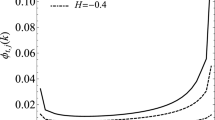Summary
The skill of the FSU Superensemble technique as applied to global numerical weather prediction is evaluated extensively in this paper. The global mass and motion fields for year 2000 and precipitation over the domain 55 S to 55 N for year 2001, as predicted by the Superensemble, the ensemble member models, and the mean of the ensemble members, are evaluated by standard statistical measures of skill to determine the performance of the Superensemble in relation to the other models. The member models are global forecast models from 5 of the world’s operational forecast centers in addition to the FSU global spectral model. For precipitation 5 additional versions of the FSU global model are utilized in the ensemble, as defined by different initial conditions provided by various physical initialization algorithms. Statistical parameters calculated for the mass and motion fields include root mean square (RMS) error, systematic error (or bias), and anomaly correlation. These are applied to the mean sea level pressure, 500 hPa heights, and the wind fields at 850 hPa and 200 hPa. Statistical parameters that were calculated for precipitation include RMS error, correlation, equitable threat score (ETS), and a special definition of bias appropriate for the precipitation field. For the mass and motion fields the performance of the Superensemble was considered for the annual global case, as well as for each hemisphere (north and south) and for each of the four seasons. For precipitation only the annual case was considered over the domain cited above.
For the mass and motion fields the RMS calculations showed the Superensemble to be superior (to have the smallest total forecast error) in all comparisons to the ensemble member models, and to be superior to the ensemble mean in the vast majority of comparisons. Performance in comparison to the other models was generally better in the Southern Hemisphere than in the Northern Hemisphere, and better in the transition seasons of fall and spring than in the extreme seasons of winter and summer. The Superensemble had the best success with mean sea level pressure, followed in order by 500 hPa geopotential heights, 850 hPa winds, and 200 hPa winds.
In the calculations of 500 hPa geopotential height anomaly correlation the Superensemble had higher scores in all comparisons to the ensemble member models, as well as higher scores in the majority of comparisons to the ensemble mean. As with the RMS error results, the Superensemble performed better in the Southern Hemisphere than in the Northern Hemisphere, and better in fall than in summer, in comparison to the other models. The superior anomaly correlation scores of the Superensemble attest to the ability of the model to forecast daily perturbations from the climatological means, perturbations that are associated with transient synoptic scale features, given the horizontal resolution in the forecast models.
In terms of systematic error reduction the Superensemble produces its most impressive results. Annual global mean sea-level pressure systematic errors for day 5 forecasts are generally in the range of ±1 hPa (compared to errors as high as 8 hPa in other models), and day 2 forecasts of 500 hPa geopotential height produced systematic errors generally in the range of ±10 meters (compared to errors as high as 60 meters in other models). The Superensemble was able to reduce systematic errors in forecasts of a variety of important features in the global mass and motion fields: surface equatorial trough, wave amplitude in geopotential heights at 500 hPa, trade winds and Somali Jet at 850 hPa, mid-latitude westerlies, subtropical jet, and Tropical Easterly Jet (TEJ) at 200 hPa.
In terms of forecasting precipitation the Superensemble outperforms all ensemble member models and the ensemble mean in terms of RMS error, correlation coefficient, equitable threat score, and bias. The superior correlation scores indicate that the Superensemble is more reliable than the other models in predicting perturbations in the area distribution of precipitation, perturbations that are essentially associated with migrant synoptic scale disturbances, considering the horizontal resolution of the forecast models.
The Superensemble is a valuable tool for significantly improving upon the global model forecasts of the world’s operational forecast centers. These forecasts are used daily as important guidance in making weather forecasts in all regions of the world. This paper will demonstrate that the Superensemble improves upon the ensemble member model forecasts: (1) in a statistical sense considering broad areas of the globe, (2) in a synoptic climatology sense through focus on the improved forecasts of climatological features seen in the global mass and motion fields, (3) in a synoptic sense through use of anomaly correlation and correlation coefficient where improvement is demonstrated in the forecasts of perturbations from mean fields which are essentially associated with transient synoptic scale disturbances.
Similar content being viewed by others
References
TN Krishnamurti CM Kishtawal TE LaRow DR Bachiochi Z Zhang CE Williford S Gadgil S Surendran (1999) ArticleTitleImproved weather and seasonal climate forecasts from multimodel superensemble. Science 285 1548–1550 Occurrence Handle1:CAS:528:DyaK1MXlslOrtr0%3D Occurrence Handle10477515
TN Krishnamurti CM Kishtawal DW Shin CE Williford (2000) ArticleTitleImproving tropical precipitation forecasts from a multianalysis superensemble. J Climate 13 4217–4227
TN Krishnamurti CM Kishtawal Z Zhang T LaRow D Bachiochi E Williford (2000) ArticleTitleMultimodel ensemble forecasts for weather and seasonal climate. J Climate 13 4196–4216
TN Krishnamurti S Surendran DW Shin RJ Correa-Torres TSVV Kumar E Williford C Kummerow RF Adler J Simpson R Kakar WS Olson FJ Turk (2001) ArticleTitleReal-time multianalysis-multimodel superensemble forecasts of precipitation using TRMM and SSM/I products. Mon Wea Rev 129 2861–2883
Author information
Authors and Affiliations
Rights and permissions
About this article
Cite this article
Ross, R., Krishnamurti, T. Reduction of forecast error for global numerical weather prediction by The Florida State University (FSU) Superensemble. Meteorol. Atmos. Phys. 88, 215–235 (2005). https://doi.org/10.1007/s00703-004-0077-8
Received:
Accepted:
Published:
Issue Date:
DOI: https://doi.org/10.1007/s00703-004-0077-8




